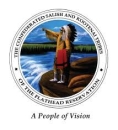Ways to Get Involved
Ninepipe National Wildlife Refuge is a wonderful place to visit, with expansive vistas, native birds, and abundant wildlife. You can do more than just enjoy the outdoors - you can become directly involved in supporting the Refuge by volunteering.
Volunteering
From its start in 1903, the National Wildlife Refuge System has owed its very existence to concerned citizens eager to protect America's natural resources. More than 42,000 people volunteer their time and ideas each year to the U.S. Fish and Wildlife Service. Whether they work on the land, in a visitor center or with youth, they contribute to the conservation mission that reaches back more than a century.
Become a volunteer to contribute your strength on behalf of America’s natural resources.
Contact us regarding available volunteer opportunities.
PO Box 547
Ronan, MT, 59864
406-750-8242
Our Partners
The National Wildlife Refuge System is committed to building partnerships which encourage conservation and preservation of our natural and cultural resources. Partnerships with the Refuge System bring innovative approaches to solving land management and water disputes in the most environmentally protective manner. Scientifically-informed and technologically-based stewardship of our public lands, waters, wildlife and special places must be collaborative efforts between the Refuge System, other government agencies, and private organizations if conservation efforts are to succeed.
The Service works with neighboring land managers, the Confederated Salish and Kootenai Tribes (CSKT) and the Montana Fish, Wildlife and Parks (MTFWP), to manage Ninepipe National Wildlife Refuge as part of a larger wetland and upland vegetation community. The very existence of Ninepipe National Wildlife Refuge is based on partnerships. The Refuge centers on Ninepipe Reservoir, developed for and managed by the Flathead Irrigation Project in 1910. At the request of the Confederated Salish and Kootenai Tribes, the Refuge was established in 1921 on Tribal Trust lands.
Under a cooperative agreement with the Confederated Salish and Kootenai Tribes, the general Tribal recreation fee is waived for non-consumptive use of Ninepipe National Wildlife Refuge by non-members of the Tribes.
Partners worked together to develop the Ninepipe Watchable Wildlife Viewing Area under a challenge cost share program in 1996 on lands owned or operated by the Service, Montana Department of Fish, Wildlife and Parks, and the Confederated Salish and Kootenai Tribes. The State developed the entrance road, parking area, interpretive area base structures and a restroom. A fully accessible trail starts at the State parking area and goes out on the Refuge. All three agencies cooperated on the development of the interpretive panels.
Ducks Unlimited constructed two islands for nesting birds in 1987. At times they assisted in planting dense nesting cover. The wild rose and snowberry plots planted in 1988 are well established and no cultivation has been required on them since 1990. These islands are typically high above water level and connected to the mainland until the reservoir receives sufficient spring melt, usually in June.
Annual Funding Agreement Information
Pursuant to the 1994 Tribal Self-Governance Act, The US Fish and Wildlife Service has negotiated, entered into and concluded Annual Funding Agreements with the Confederated Salish and Kootenai Tribes (CSKT). These partnerships between the Service and CSKT are government-to-government relationships and provide for the Tribes to have a substantive role in mission-critical programs of select units of the National Bison Range Complex, including Ninepipe National Wildlife Refuge, which remain units of the National Wildlife Refuge System.
The Service issued a Notice of Intent to prepare an Environmental Assessment regarding the Interest of the Confederated Salish and Kootenai Tribes to enter into an Annual Funding Agreement with the Department of the Interior, U.S. Fish and Wildlife Service. This will assess the Draft Fiscal Year 2013-2016 Annual Funding Agreement between the United States Department of the Interior and the CSKT. We will post information and links when the Environmental Assessment is ready for public comment.
Education Programs
The mission of the National Wildlife Refuge System is to preserve a national network of lands and waters for the conservation and management of fish, wildlife and plant resources of the United States for the benefit of present and future generations. By educating students and their teachers, we will be influencing the future stewards of our public lands. To encourage use of the Refuge by young people, fees are waived for youth and educational groups.
Ninepipe National Wildlife Refuge and the other units of the offers numerous facilities, programs materials and equipment for teachers and classes.
For information contact:
Amy Lisk, Refuge Manager, 406-564-9890

